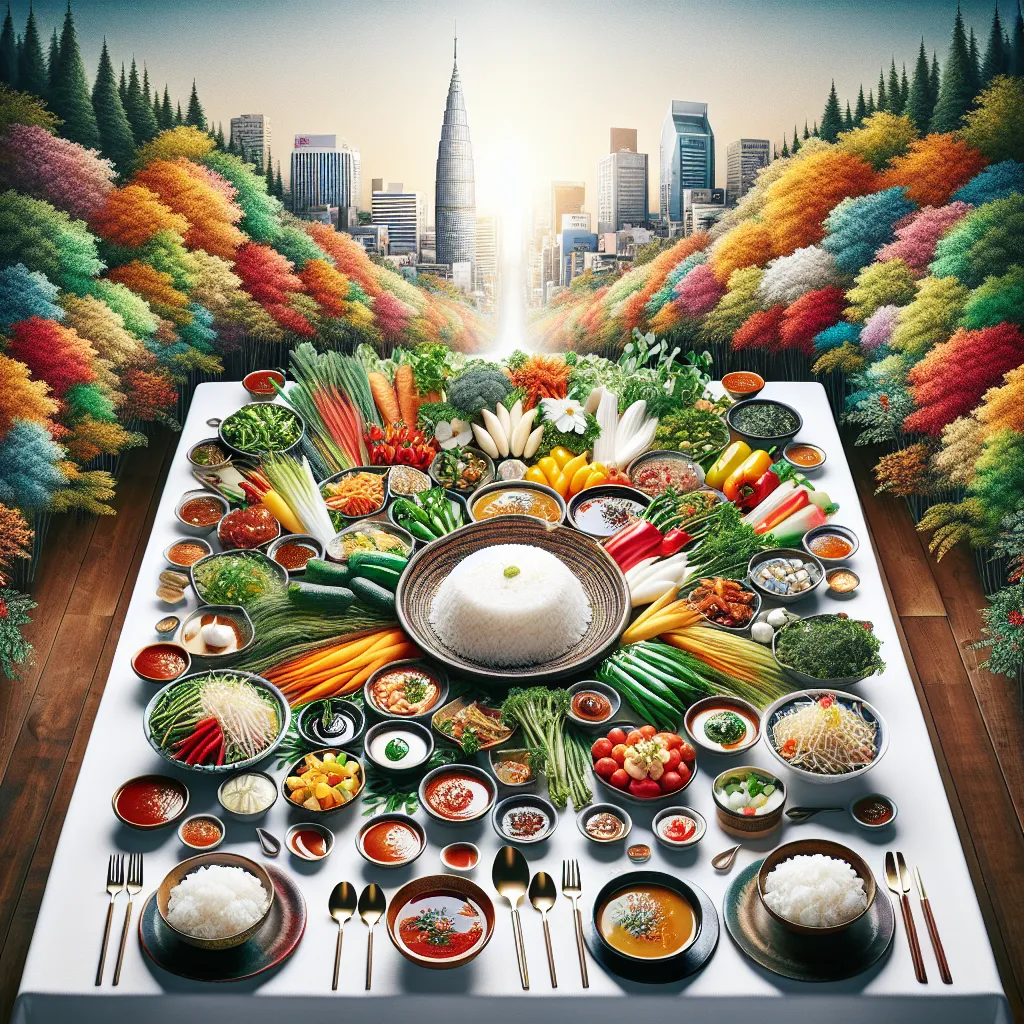As you sit down to enjoy a meal in Gwangju, you can’t help but be drawn to the delightful flavors of Ssambap, a traditional dish that perfectly encapsulates the essence of the city. The combination of fresh vegetables, savory rice, and a variety of sauces creates a culinary experience like no other. Let’s delve into the origins of Ssambap in Gwangju, explore the vibrant array of vegetables used in this dish, uncover the secrets behind the traditional sauces that elevate its taste, and discover how modern twists have brought new life to this classic favorite. Get ready to embark on a journey through the rich culinary heritage of Gwangju, where each bite tells a story of tradition, innovation, and the vibrant spirit of this charming city.

The Origin of Ssambap in Gwangju
Hey there, foodies! Today, let’s dive into the fascinating origins of Ssambap in Gwangju, South Korea. Ssambap, a traditional Korean dish, is all about wrapping rice and various vegetables in a delicious bundle of joy. But have you ever wondered how this delightful dish came to be a beloved part of Gwangju’s culinary scene?
Discovering the Roots of Ssambap
Well, let me take you on a journey back in time to discover the roots of Ssambap in Gwangju. The history of Ssambap dates back to the Three Kingdoms period in Korean history, around 57 BC to 668 AD. During this time, rice cultivation was flourishing in the fertile region of Gwangju, leading to an abundance of rice and vegetables. The locals, known for their innovative culinary skills, began combining these fresh ingredients to create a simple yet flavorful dish – Ssambap.
As the years went by, Ssambap evolved and became a staple in Gwangju’s food culture. The dish gained popularity not only for its delicious taste but also for its health benefits. Ssambap is packed with nutrients from the fresh vegetables and rice, making it a wholesome and satisfying meal for people of all ages.
In Gwangju, Ssambap is often enjoyed with a variety of savory sauces, each adding a unique flavor to the wrap. From spicy gochujang to tangy soy sauce, the sauces elevate the taste of Ssambap and make each bite a burst of deliciousness. The art of wrapping the ingredients in a delicate lettuce leaf or perilla leaf is also a cherished tradition in Gwangju, adding a fun and interactive element to the dining experience.
Today, Ssambap remains a beloved dish in Gwangju, enjoyed by locals and visitors alike. Whether you’re exploring the bustling streets of downtown Gwangju or dining in a cozy traditional restaurant, you’re sure to encounter the delightful aroma of Ssambap being prepared with love and care.
So, the next time you find yourself in Gwangju, be sure to indulge in a plate of Ssambap and experience the rich culinary heritage of this vibrant city. From its humble beginnings in ancient times to its present-day popularity, Ssambap truly embodies the essence of Gwangju’s food culture.
A Variety of Vegetables Used in Gwangju’s Ssambap
Hey there, foodies! Let’s dive into the colorful world of Gwangju’s Ssambap and explore the wide array of vegetables that make this dish so delicious and nutritious! 🥬🥕🌶️
The Beauty of Ssambap
In Gwangju, Ssambap is a popular dish that consists of rice and an assortment of fresh vegetables wrapped in lettuce or perilla leaves. The beauty of Ssambap lies in its versatility, allowing you to mix and match different vegetables to create your perfect bite. From crunchy cucumbers to spicy peppers, Gwangju’s Ssambap offers a symphony of flavors and textures that will tantalize your taste buds. 🍚🥒🌿
Key Vegetables in Ssambap
One of the key vegetables used in Gwangju’s Ssambap is lettuce. Crisp and refreshing, lettuce provides a neutral base for the other ingredients, allowing their flavors to shine through. It also adds a satisfying crunch to each bite, enhancing the overall eating experience. In addition to lettuce, perilla leaves are often used in Ssambap for their unique aroma and earthy taste. These leaves add a fragrant note to the dish, elevating its flavor profile. 🥬🌿
When it comes to adding a kick of heat, spicy peppers are a must-have in Gwangju’s Ssambap. Whether you prefer the fiery heat of Korean red peppers or the milder spice of jalapeños, these peppers bring a spicy punch to the dish, balancing out the other flavors. For those who enjoy a bit of sweetness, carrots are a popular choice in Ssambap. Sliced thinly and added to the wrap, carrots provide a subtle sweetness that complements the savory elements of the dish. 🌶️🥕
To add a burst of freshness, cucumbers are often included in Gwangju’s Ssambap. Cool and crunchy, cucumbers offer a refreshing contrast to the other ingredients, making each bite a delightful mix of flavors and textures. Their high water content also helps keep the dish light and hydrating. 🥒💧
So, the next time you’re in Gwangju, be sure to try Ssambap and savor the diverse range of vegetables that come together to create this mouthwatering dish. With each bite, you’ll experience a symphony of flavors that celebrate the bounty of nature. Enjoy! 🌈🍽️
Exploring Traditional Sauces for Gwangju’s Ssambap
Welcome to the flavorful world of Gwangju’s Ssambap, where rice and vegetable wraps come alive with a symphony of traditional sauces! 🌶️🍚
The Iconic Gochujang Sauce
In Gwangju, the heart of Jeolla Province in South Korea, Ssambap is a beloved dish that celebrates the region’s rich culinary heritage. What sets Gwangju’s Ssambap apart are the array of traditional sauces that accompany the fresh ingredients, elevating the dining experience to new heights! 🌿🥢
Gochujang: A Flavorful Kick
One of the most iconic sauces you’ll encounter is Gochujang, a spicy and savory red chili paste that adds a kick of flavor to each bite. Made from fermented soybeans, glutinous rice, and red chili powder, Gochujang strikes the perfect balance between heat and umami, creating a taste sensation that will leave you craving for more! 🔥🍶
Ssamjang: A Harmonious Blend
Another staple sauce in Gwangju’s Ssambap is Ssamjang, a delectable mixture of fermented soybean paste, red chili pepper paste, sesame oil, garlic, and green onions. This savory and slightly sweet sauce enhances the natural flavors of the fresh vegetables and rice, creating a harmonious blend of textures and tastes in every wrap. 🌶️🥬
Cho-gochujang: A Milder Option
For those who prefer a milder option, Cho-gochujang is the perfect choice. This sauce combines Gochujang with vinegar, sugar, and sesame seeds, resulting in a tangy and slightly sweet flavor profile that complements the crispness of the vegetables and the nuttiness of the rice. It’s a match made in culinary heaven! 🍯🌰
Saeujeot: A Bold Flavor Addition
And let’s not forget about Saeujeot, a traditional Korean fermented shrimp sauce that adds a unique depth of flavor to Gwangju’s Ssambap. With its salty and pungent taste, Saeujeot provides a bold contrast to the freshness of the vegetables, creating a truly unforgettable dining experience. 🦐🍚
So, the next time you find yourself in Gwangju, be sure to indulge in the vibrant world of Ssambap and explore the diverse array of traditional sauces that make this dish a true culinary masterpiece. Your taste buds will thank you for the adventure! 🌟🍴
Remember, in Gwangju’s Ssambap, every wrap tells a story, and every sauce adds a delicious twist to the tale. Embrace the flavors, savor the moment, and enjoy the journey through the rich tapestry of traditional Korean cuisine! Bon appétit! 🇰🇷🎉
Modern Twists on Gwangju’s Classic Ssambap
Hey there, foodies! Today, let’s dive into the vibrant world of Gwangju’s classic ssambap, but with a modern twist that will tickle your taste buds and leave you craving for more. Ssambap, a traditional Korean dish, consists of rice and various vegetables wrapped in fresh lettuce or perilla leaves, accompanied by an array of flavorful sauces. In Gwangju, this dish takes on a whole new level of deliciousness with innovative ingredients and creative combinations. Let’s explore how chefs in Gwangju are reimagining this beloved dish to suit the modern palate!
Imagining a Colorful Culinary Experience
Picture this: a colorful array of fresh vegetables, tender slices of grilled meat, and a rainbow of sauces laid out before you. This is the beauty of ssambap in Gwangju – a feast for both the eyes and the taste buds. Chefs in Gwangju are known for their creativity in combining traditional flavors with contemporary elements, resulting in a culinary experience like no other.
Exploring Innovative Ingredients
One of the modern twists on Gwangju’s classic ssambap is the use of unique ingredients such as edible flowers, microgreens, and exotic fruits to elevate the dish to a whole new level. Imagine wrapping a piece of succulent pork belly with a sprinkle of edible flower petals and a drizzle of tangy fruit-infused sauce – a burst of flavors in every bite!
Playing with Textures and Temperatures
Not only are chefs in Gwangju experimenting with ingredients, but they are also playing with textures and temperatures to create a multi-dimensional dining experience. Crispy tempura flakes, creamy avocado slices, and icy cold kimchi are just some of the elements that add a surprising twist to the traditional ssambap.
Secret Weapons: Flavorful Sauces
Let’s not forget about the sauces! Gwangju’s ssambap scene is buzzing with a variety of house-made sauces that range from spicy gochujang mayo to sweet and savory soy garlic glaze. These sauces are the secret weapons that tie all the elements of ssambap together, creating a harmonious symphony of flavors in every wrap.
Visual Presentation: A Feast for the Eyes
In addition to the culinary innovations, Gwangju’s ssambap restaurants also focus on the visual presentation of the dish. Each wrap is meticulously crafted to be not only delicious but also Instagram-worthy, making dining an experience for all the senses.
So, if you find yourself in Gwangju, be sure to indulge in the modern twists on the classic ssambap. From unique ingredients to creative flavor combinations, Gwangju’s ssambap scene is a culinary adventure waiting to be explored. Get ready to wrap, roll, and savor every bite of this iconic Korean dish with a contemporary twist! 🌿🍲🌶️
As you explore the vibrant food culture of Gwangju through its iconic dish, Ssambap, you are not just savoring a meal but immersing yourself in a rich tapestry of flavors, textures, and traditions. From the origins of Ssambap to the array of fresh vegetables used, and the traditional sauces that elevate the dish, each bite tells a story of the city’s culinary heritage. And as modern twists add a new dimension to this classic dish, the essence of Gwangju’s Ssambap remains rooted in its simplicity and community spirit. Embrace the rice and vegetable wraps, drizzle on the sauces, and savor every moment, for in Gwangju’s Ssambap, you taste the heart and soul of a city that welcomes you with open arms.
